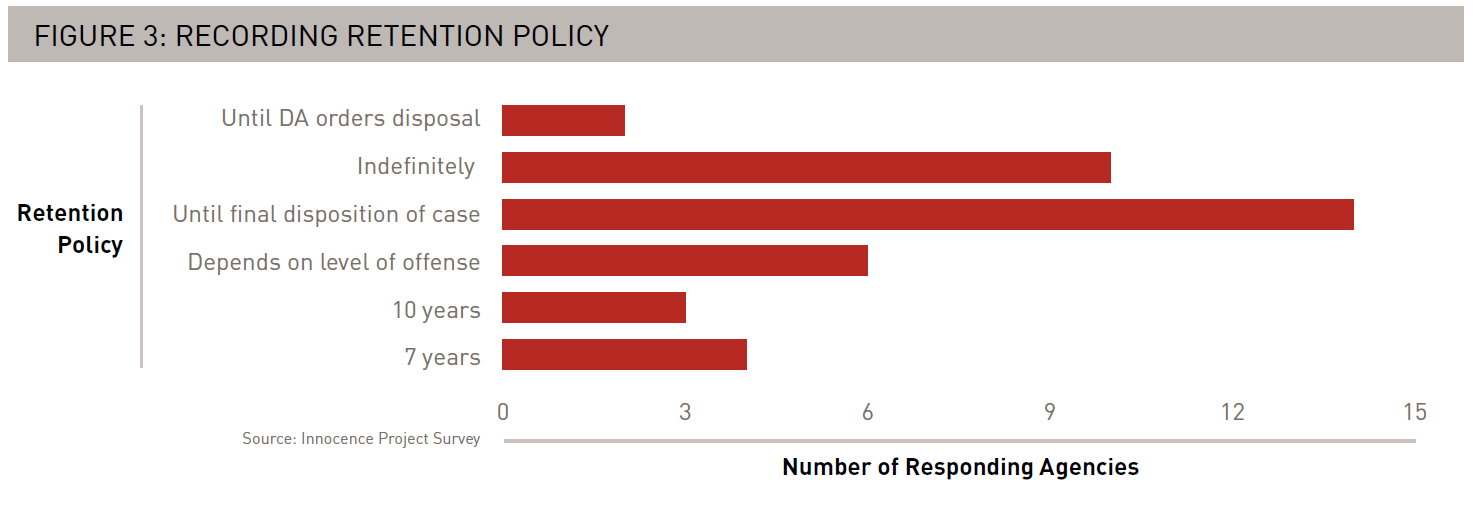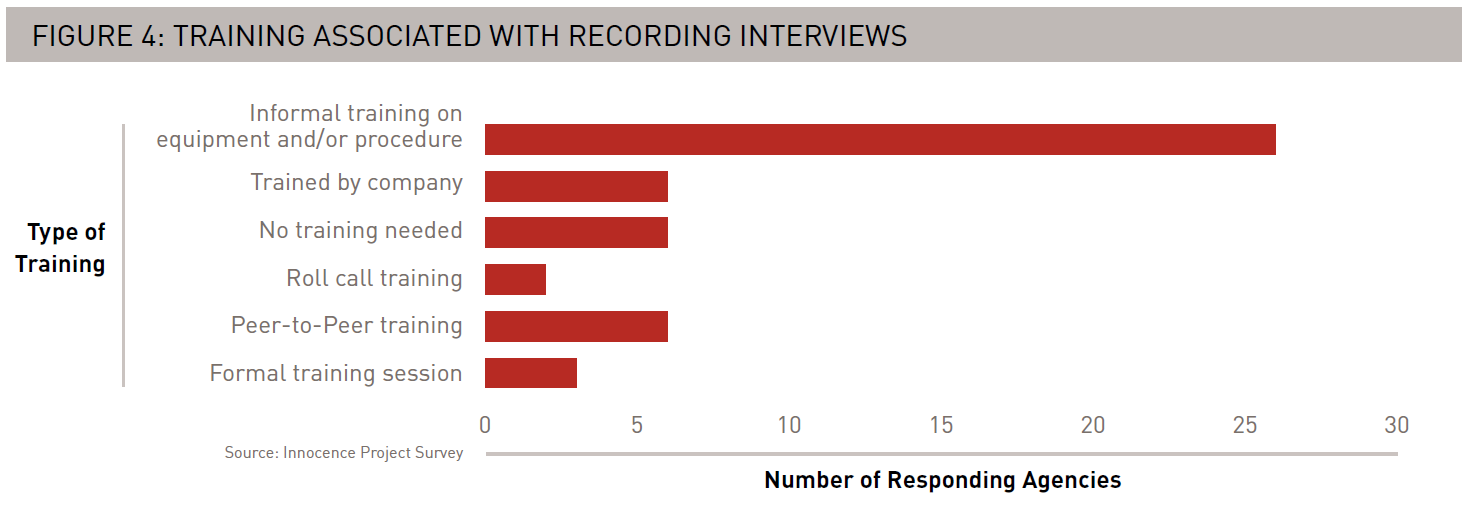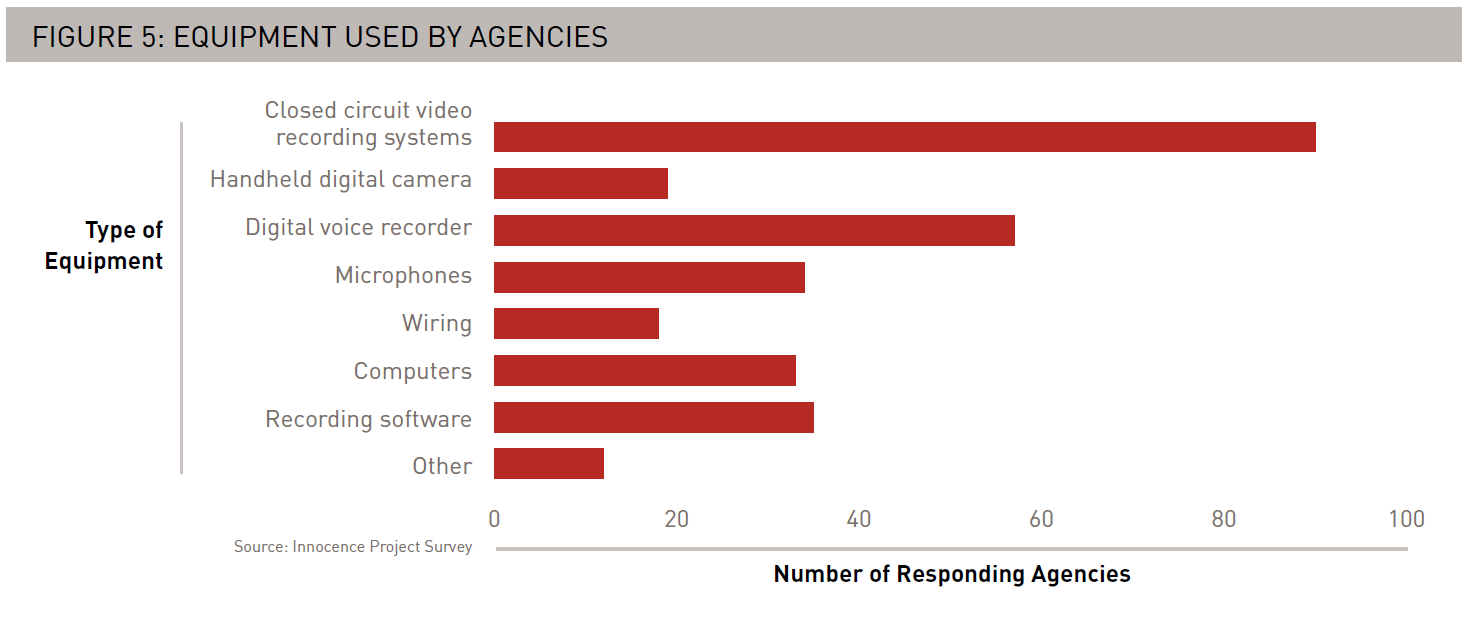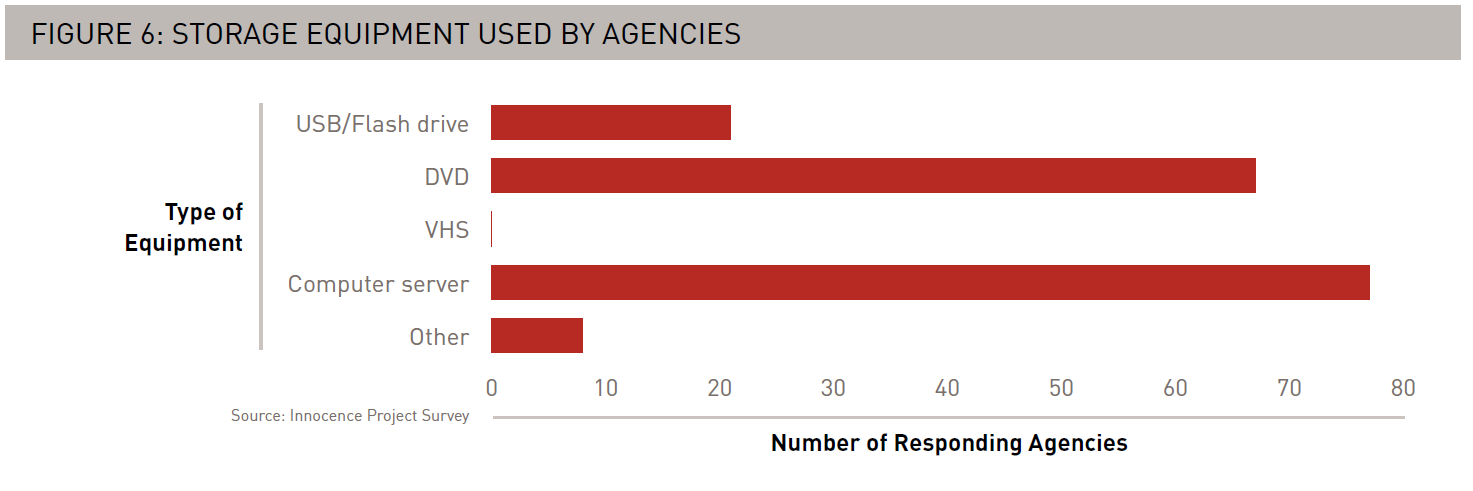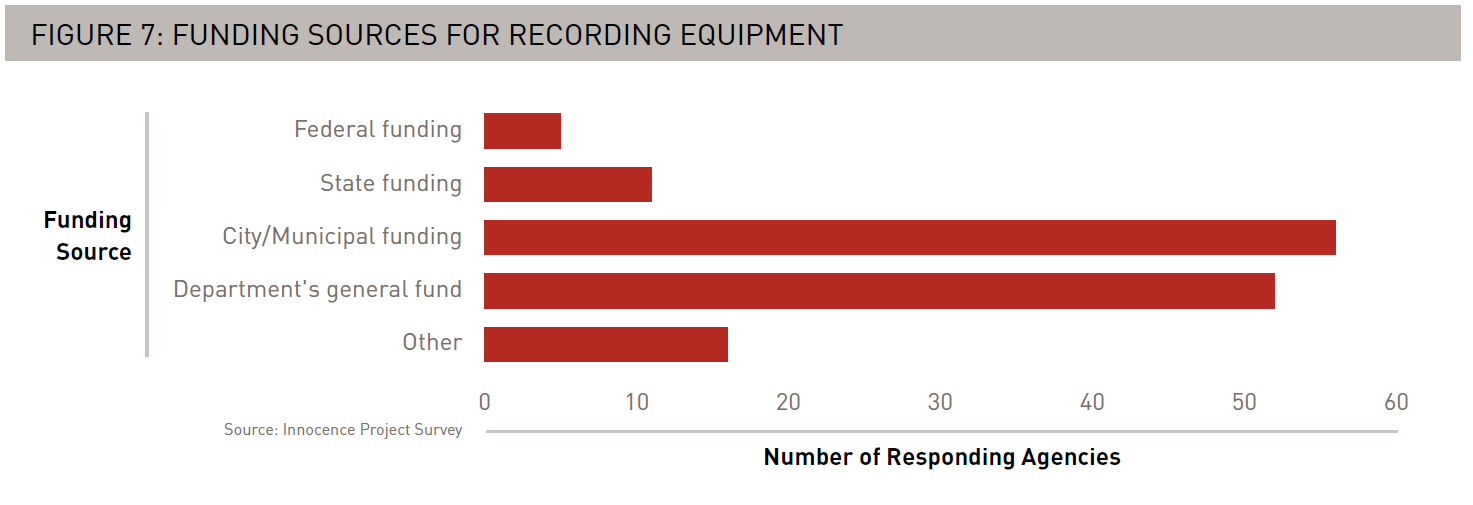Introduction
Twenty-first century policing requires law enforcement to effectively reduce crime, while establishing trust and legitimacy with the communities they serve. Electronic recording of custodial interviews can help law enforcement meet these demands by providing an irrefutable account of what transpired during a critical interaction between police and suspects. The practice can prevent false confessions and substantiate authentic ones—increasing overall public confidence in the justice system.
There is a growing national movement to electronically record custodial interviews. Currently, 18 states and the District of Columbia have mandated the practice either by statute (CT, IL, MD, MI, MO, MT, NE, NM, NC, OR, VT, WI) or court action (AK, IN, MA, ME, MN, NJ). In another four states the vast majority of law enforcement agencies have voluntarily implemented the practice (AZ, HI, UT, RI). In addition, hundreds of individual jurisdictions throughout the country have adopted electronic recording of interviews on their own.
On the federal level, the U.S. Department of Justice announced in 2014 that the Federal Bureau of Investigations (FBI), the Drug Enforcement Administration (DEA), the Bureau of Alcohol, Tobacco, Firearms, and Explosives (ATF) and the United States Marshals Services would electronically record custodial interviews in connection with all federal crimes. National groups such as the Major Cities Chiefs Association, the International Association of Chiefs of Police (IACP) and the American Bar Association have endorsed recording as a best practice.
The Innocence Project views recording custodial interviews as a key protection against wrongful convictions and works with law enforcement agencies across the country to help them adopt the practice. This primer is intended to guide agencies on the operational and technical aspects of implementation. It is based on the experiences of over 100 agencies that currently record custodial interrogations, as reported in a 2015 survey conducted by the Innocence Project, as well as research and recommendations from law enforcement organizations, legal associations, and academics.
About the Survey
In 2015, the Innocence Project surveyed agencies that record custodial interviews about their experiences with the operational and technical aspects of the practice, specifically regarding:
• Departmental policies and procedures on recording interviews, data storage and transcription.
• Types of equipment used for recording and retaining custodial interviews.
• Costs and funding sources associated with recording custodial interviews.
We focused on agencies in two jurisdictions that regularly electronically record custodial interrogations. Law enforcement associations in two such states—Massachusetts and Wisconsin—kindly agreed to distribute electronic copies of the survey to their members. Both Massachusetts case law and Wisconsin’s statute establish that if an interview is not electronically recorded, defendants are entitled to a cautionary jury instruction concerning the use of such evidence.1 Law enforcement in Massachusetts have been recording since 2004 and agencies in Wisconsin since 2005.
The survey was emailed to agencies and responses were collected from April 14, 2015 through June 10, 2015. We received responses from 111 agencies—77 in Massachusetts and 34 in Wisconsin. With a total of 351 police agencies in Massachusetts and 429 in Wisconsin, the response rate was 22 percent and 8 percent respectively.2 Responding agencies covered jurisdictions with populations ranging from 530 to 599,164, with an average population of 20,034 (see fig. 1). The number of sworn personnel at responding agencies ranged from 5 to 107, with the highest number of agencies employing between 20 and 30 officers (see fig. 2).
The Innocence Project survey did not use generally accepted sampling techniques, nor did it capture the experiences of agencies in all states covered by mandatory electronic recording policies.
Why Record Interviews?
Law enforcement officers with experience electronically recording interrogations provide compelling reasons to record, describing both benefits for law enforcement and the innocent. In 2004, former U.S. Attorney Thomas Sullivan and his associates surveyed over 238 agencies in 38 states on their experiences with the practice, and published the results in a report titled, “Police Experiences with Recording Interrogations.”3 Officers with whom they spoke overwhelmingly and enthusiastically supported electronically recording custodial interviews.
Those surveyed said that the practice dramatically lowered the number of defense motions to suppress statements and confessions and reduced complaints about officer conduct. In addition, detectives reported that recording allowed them to focus on the interview and suspect, rather than on the copious taking of notes, and to easily recall details when writing reports or testifying about past interviews. Some of the feedback in Sullivan’s survey included the following:
• Commerce City, Colorado, Police Department — “Recordings are ‘invaluable to us [in] resolving disputes regarding confessions.’ ”
• Bozeman, Montana, Police Department — “Recordings permit the viewer to see how the suspect looked and acted before being ‘cleaned up’ for court. One video showed a suspect giggling when he described beating children. Our experience is 100 percent positive.”
• Salt Lake City, Utah, Police Department — “Since the department has been using video to record interrogations there have been no complaints about voluntariness or coercion. Videotaping statements helps us put forth the best case possible.”
• Contra Costa County, California, Sheriff ’s Office — “Recordings allow detectives to later dissect the tapes for the words used and mannerisms of the suspect, and voice inflections. These are subtleties that may go unnoticed without the benefit of a recording.”
• Savannah, Georgia, Police Department — “Detectives frequently prepare reports or testify weeks or months after the interviews, and in the interim they have conducted many other interviews. Recollections of details fades. Recordings allow officers to be accurate and complete.”
Recording custodial interviews can also prevent wrongful convictions stemming from false confessions. False confessions played a role in 28 percent of the nation’s 330 DNA-based exoneration cases. While illegal or coercive interview tactics were used in some of these cases, even the most standard interview can lead to a false confession. An electronic recording can provide a safety valve in these instances.
For example, former detective Jim Trainum of the Washington D.C., Metropolitan Police Department recalls how his first major homicide investigation resulted in a false confession. Although the female suspect he interviewed initially claimed to be innocent, she later confessed and was charged with first-degree murder. Later, Trainum discovered that she had an ironclad alibi and could not have committed the crime. To understand what went wrong, he reviewed the recording and realized that he had inadvertently fed her details of the crime that she repeated back in her confession. If the police hadn’t verified the alibi the woman might have been wrongfully convicted of murder. The recorded interrogation revealed how a false confession could be prompted even by well-intentioned, conscientious officers.
This case is just one example of how false confessions can potentially lead to wrongful convictions, which harm the innocent and threaten public safety. Of the nation’s 330 DNA exonerations, 142 real perpetrators were later identified and had gone on to commit 145 additional crimes—including 77 rapes and 34 murders—while the wrong person was in prison. By removing doubt about the reliability of authentic confessions and providing a safety net if a false confession occurs, recording custodial interviewshelps to ensure that the right person is detected.
Recommendations for Implementation
I. Developing Policies and Procedures
A written departmental policy on recording of custodial interviews is critical to ensuring that procedures are properly and uniformly followed during investigations. Ninety percent of Innocent Project survey respondents said that their departments had written policies on recording custodial interviews. This section discusses factors that should be considered when developing policies and procedures.
A. General Best Practices
The best practices listed below are taken from the IACP model policy and training key for electronically recording custodial interviews, the U.S. Department of Justice memo on electronically recording interviews for federal crimes and social science research. They are explained in greater detail in the sections that follow.
1. Cameras and other recording equipment should be set up in dedicated custodial interview rooms ahead of time. Cameras should be positioned in a way that includes both the suspect and interviewer in the field of view.
2. Officers should electronically record custodial interviews conducted in a place of detention involving, at minimum, major crimes such as homicide, sexual assault and armed robbery.
3. Each state must look to its own law to determine whether or not suspects must be informed that they are being recorded.
4. Laws or policies should articulate any exceptions to the practice of recording interviews, and deviations from the practice should be documented. For instance, if electronic recordings cannot occur because of equipment failure, lack of suspect cooperation, spontaneous statements made outside of the interview room or other circumstances, the reason should be documented.
5. Custodial interviews and confessions should be recorded in their entirety, as follows:
• Recording should begin before the suspect enters the room and conclude when the interviewer and suspect leave the room.
• At the beginning of the recording, the interviewing officer should ensure that voice identifications are made of the officers, suspect and any others present, followed by a declaration of the time, date and location of the recording.
• The interviewing officer should verbally declare when the interview has begun, with concurrence from the suspect.
• Miranda warnings should be administered, even if the recording is a follow up to a prior interview or the suspect has been previously Mirandized.
• Any lapse in the recording for comfort breaks or other reasons should be explained, or the recording should continue during breaks.
• The interviewing officer should declare when the custodial interview has ended and note the date and time of termination.
6. All recordings of custodial interviews are evidence and should be governed by departmental policies on handling and preserving evidence. In addition:
• Interviews should be recorded only on previously unused media.
• Both the original and copies of all recordings should be protected from re-recording.
• Only one custodial interview should be recorded on each recording media.
• Before submitting the original recording to a secure evidence storage area, copies should be made and maintained in the investigative unit. Recordings should be marked as “original” or “copy.”
• The detective’s follow-up report should note if and how the interview was recorded.
B. Recording in a Custodial Setting
A “custodial” setting is typically defined as a place of detention such as a police station or jail. An objective standard for determining a suspect’s custodial status is whether a reasonable person would believe that he or she was not free to leave. In Miranda v. Arizona, the U.S. Supreme Court ruled that a custodial interview refers not only to express questioning, but also to “words or actions on the part of police officers that they should have known were reasonably likely to elicit an incriminating statement.”8
There is specific reference to recording “custodial interviews” in all state laws and court rules/decisions that mandate the practice. This means that officers would not be required to record fact-finding interviews of non-suspects conducted at a police station or spontaneous statements made by a suspect at a crime scene during questioning before he or she is Mirandized or taken into custody.9
The IACP training key states that the transporting officers and others involved in the pre-interview phase do not have to refrain from talking to a suspect who has indicated a willingness to talk either at the crime scene or en route to the place of detention. However, it also advises that officers should not purposely interview a suspect in a non-custodial setting to avoid electronic recording requirements.10
C. Recording Confessions Only vs. Recording the Entire Interview
The value of the recording is in the whole interview, not merely the confession. The IACP training key recommends recording interviews in their entirety as opposed to confessions only, stating “this is the only positive means by which police can demonstrate that interviews were conducted properly and confessions elicited legally.”11 Recording only the confession without the interview that led up to it will do little to convince judges and juries about the voluntariness of the statement or to protect officers against claims of coercion and abuse. Additionally, recording only the confession—as opposed to the entire interview— will not serve as a safeguard to prevent the wrongful conviction of the innocent.
Reviewing recordings of the entire interview can help detectives identify important details that may have been initially overlooked, such as false alibis, inconsistent statements and body language. Finally, it allows for training and self-evaluation. Many agencies in Sullivan’s survey reported using recordings to teach interview tactics to both new recruits and veteran officers.12
D. Recording Interviews for Specific Crime Categories
It is generally accepted that recording interrogations is most important for serious crimes. The IACP model policy recommends recording custodial interviews for major crimes such as homicide, sexual assault, robbery and other Part I crimes as defined by the FBI. Three states (AK, MA, MN) require and it is federal policy to electronically record custodial interviews for all crimes. Fifteen states (CT, IL, IN, MD, ME, MI, MO, MT, NE, NJ, NM, NC, OR, VT, WI) and the District of Columbia electronically record custodial interviews for serious crimes or all felonies. At a minimum, recording should be required for cases involving major crimes and/or violent felonies.
E. Audiovisual or Audio-Only Recording?
Video can provide insight into the nonverbal cues and body language of defendants—an invaluable tool for investigators and prosecutors that is lost in transcripts and audio-only recordings.13 In addition, the inability to see the interrogator or suspect can cast doubt on the voluntariness of a confession. The Innocence Project survey results indicate a preference for audiovisual over audio-only recordings. While both Massachusetts and Wisconsin permit either audiovisual or audio-only recordings of custodial interviews, 94 percent of respondents reported having equipment that could capture both audio and video.
F. Best Camera Angle for Recording
Research shows that camera angles capturing both the interviewer and suspect allow fact finders to see interviews in a full, accurate and balanced manner, while focusing the camera on the suspect only is harmful to the innocent.14 The IACP training key advises “interviewing officers should be on tape as opposed to being videotaped from behind facing the suspect and only heard conducting the interview.”15 In the Innocence Project survey, 70 percent of agencies reported aiming cameras at both the suspect and interviewer or using two or more cameras to capture both parties. Approximately one-quarter of respondents aimed the camera at the suspect only.
G. Covert or Overt Recording?
State law typically determines whether a suspect must consent to be recorded or an agency is permitted to secretly record. There are 11“two-party” consent states that require a suspect to be made aware of, or to agree to, the electronic recording of a custodial interview— CA, CT, FL, IL, MD, MA, MT, NH, PA, WA and WI.16 In Maryland, however, the law mandating the recording of interrogations contains an exception to the two-party consent rule for the purposes of custodial interviews. In other states the suspect does not have to be notified that he or she is being recorded. Laws or court action have already required recording of interrogations in eight of the eleven “two-party” consent states.
There is no evidence that suggests suspects will be less willing to talk if they know they are being recorded. According to Sullivan’s report, “most detectives we spoke with said that suspects’ awareness of being recorded is not a hindrance, because when interviews get underway any initial hesitation fades and suspects focus attention on the subject of their interview.”17
Chief Bill Brooks of the Norwood, Massachusetts, Police Department, whose officers have regularly recorded interrogations for decades, told the Innocence Project that implementing the practice in a two-party consent state has not had an impact on suspect cooperation during an interview.
“I thought that recording the entire interrogation would expose investigative procedures and techniques and that it might have a chilling effect on suspects,” he said. “Once we started doing it, I became a believer. We tell the suspect being interviewed at the outset that everything said in the room is recorded, and we simply begin the interview. If the suspect objects to the recording, we explain why it’s in his best interests. If he still objects, then we turn the equipment off. The vast majority of our suspects don’t react when we tell them that the interview is being recorded.”
To address concerns that suspects will be distracted or uncooperative in front of a camera, agencies may want to use discreet devices such as bubble cameras and hidden microphones. In the Innocence Project survey, a majority of agencies reported using equipment that is positioned in a way that does not draw the suspect’s attention (57 percent).
H. Retaining Recordings
Recordings are evidence and should be governed by departmental policies on handling and preserving evidence. The majority of agencies (66 percent) reported in the Innocence Project survey that they either retain recordings indefinitely or until final disposition of the case (see fig. 3).
There is value in retaining recordings until at least the end of a sentence for a serious violent crime to help substantiate a valid conviction during appeals and other post-conviction proceedings or, in the case of a false confession, to prove innocence.
II. Training
The vast majority of law enforcement agencies recognize that training is essential for officers who are going to record interrogations. In the Innocence Project survey, 94 percent of respondents said that officers were trained on how to operate recording and storage equipment. The highest number of respondents described informal, on-the-job training on equipment operations and/or custodial interview procedures (44 percent). As is shown in figure 4, 22 percent said that officers received training from the vendor or their peers. Ten percent said that training was done through formal sessions or roll-call videos. Eleven percent said that the equipment was simple and no training was necessary (e.g. a matter of pressing a button to turn equipment on and off). Based on these responses, training should require minimal time and resources.
III. Equipment
Costs, capabilities and ease of use are all considerations in the purchase of recording equipment. The appropriate type of recording equipment for each agency will depend on the number of interviews conducted, departmental policies and available funding.
A. Types of Equipment and Costs
Equipment options and associated costs discussed in the following section are based on responses to the Innocence Project’s survey and represent the experiences of 111 agencies that have purchased and maintained equipment to record custodial interviews (see fig. 5).
High-Tech Options: Based on responses to the Innocence Project survey, high-tech options for recording equipment include digital interview management systems that may come with cameras, microphones, recording software and wiring. The vast majority of agencies (81 percent) reported recording interviews with closed circuit camera systems in conjunction with other equipment. The average cost for such a system was $14,774, and prices ranged from $500 for a closed circuit video recording system and digital voice recorder to $125,000 for a system that includes closed circuit video recording, digital voice recorders, microphones, computers, recording software and DVDs.
Some digital interview management systems have features that allow investigators to simultaneously record in multiple rooms, add annotations to frames, send text message/emails to interviewers in interview rooms, store recordings in searchable databases and export recordings to DVDs, USBs and other devices. These features may be useful to agencies that conduct a large number of interviews.
Low-Tech Options: Lower-tech options for recording equipment include digital voice recorders and handheld cameras. In the Innocence Project survey, seven agencies reported recording audio-only with digital voice recorders, and prices ranged from $89 for a simple device to $1,500 for a voice recorder linked directly to a computer system. One agency reported using a handheld digital camera purchased for $50 from Best Buy.
Body-Worn Cameras: A growing number of law enforcement agencies are purchasing body-worn cameras, and in addition to capturing field interactions, many of these devices can be used to record custodial interviews. To understand whether body-worn cameras could serve both purposes, the Innocence Project contacted several federally recognized vendors.18
The vendors that responded to our inquiry—including Digital Ally, MPH Industries, Reveal Media, Safety Vision and LEA-AID—identified several types of body-worn cameras that would allow both the interviewer and suspect to be in the camera’s field of view.19 The prices ranged from $119.95 to over $800 per device. For departments that do not have interview rooms equipped with recording systems, body-worn cameras may be a practical alternative for recording interviews.
Storage, Installation and Maintenance: In the Innocence Project survey, the majority of agencies reported using computer servers (70 percent) and/or DVDs (60 percent) to store recordings (see fig. 6). The majority of agencies said that installation was included with equipment purchases or that the system was self-installed (71 percent). Most agencies reported no maintenance costs (63 percent). For those that did have to pay for maintenance, costs ranged from $100 to $2,000 per year.
B. Transcriptions
Audio transcription is another possible cost associated with recording custodial interviews. However, in the Innocence Project survey 70 percent of responding agencies said that they do not transcribe interviews, and 13 percent said that the prosecutor’s office was responsible for transcriptions. Most of the agencies that did report transcribing interviews said it was done on a case-by-case basis or when requested by the prosecutor. Only two agencies reported transcribing all interviews. Transcription prices are typically set per minute or hour and depend on the length of the audio and transcription time required.
C. Funding Equipment
Law enforcement agencies that do not yet record are often concerned about finding new funds to purchase equipment. As discussed earlier, the costs may be much less substantial than feared depending upon the size and needs of the agency. As illustrated in figure 7, most agencies surveyed by the Innocence Project responded that they used municipal and/or departmental funding to cover equipment costs. The responses also revealed some creative funding sources. One agency purchased equipment with a grant from the manufacturer and another with funding from their risk management association. Three agencies reported receiving private donations, and three used forfeiture money to pay for equipment.
Smaller agencies with limited resources may consider establishing equipment-sharing agreements with other departments. In the Innocence Project survey, 22 percent of respondents reported having equipment-sharing agreements. Of those that have a sharing agreement, most said that they have informal arrangements that allow local, state and federal law enforcement to use equipment as needed.
D. Cost vs. Benefits of Recording
Recording custodial interviews can result in long-term efficiencies that may outweigh the initial costs of purchasing equipment and training staff. Thomas Sullivan’s report on law enforcement experiences with the practice listed the following potential savings: fewer pretrial motions to suppress statements and confessions, which results in reduced court time for officers; an increased number of guilty pleas; fewer hours spent reviewing and piecing together notes from interviews; and reductions in lawsuits stemming from frivolous claims of officer misconduct during custodial interviews.
In addition, Chief Bill Brooks notes that recording custodial interviews has nearly eliminated the need for officers to testify in suppression hearings. In the past, officers had to testify at these hearings to establish what occurred in the interrogation room, but this is unnecessary when there is an electronic record. Defense attorneys may still file motions to suppress confessions and statements, but the evidentiary hearings focus on points of law rather than disputes over what happened during the custodial interview.
Sullivan’s report stated: “In the many conversations we had with police throughout the country, very few mentioned cost as a burden, and none suggested that cost warranted abandoning recordings.”20 With digital cameras available for as little as $50 each, recording of custodial interviews is likely to be a cost efficient enhancement for agencies.
Conclusion
Interviewing suspects is one of the most critical aspects of police work, and juries and judges have come to expect video recordings to verify what occurred during these closed-door sessions. Adopting this practice is easier than ever before. Advances in video technology have reduced costs and simplified the use of recording devices, and there are a number of affordable high and low-tech equipment options for agencies to consider. The Innocence Project hopes that this primer will assist law enforcement with implementing the electronic recordation of custodial interviews so that agencies can benefit from enhanced crime-solving abilities and greater public trust in the system.
Acknowledgements
The Innocence Project would like to thank the Massachusetts Chiefs of Police Association, Wisconsin Chiefs of Police Association and its members who participated in the survey on recording custodial interviews, Chief Bill Brooks and Jim Trainum. The Innocence Project’s Policy Department would like to extend a special thank you to Policy Intern Zarinah Cogbill for making this report possible.
End notes
1 Commonwealth v. DiGiambattista. 442 Mass. 423 (August 16, 2004).
2 U.S. Department of Justice. Bureau of Justice Statistics (2011). Census of State and Local Law Enforcement Agencies 2008. Retrieved from http://www.bjs.gov/content/
pub/pdf/csllea08.pdf.
3 Thomas P. Sullivan, “Police Experiences with Recording Custodial Interrogation,” Northwestern University School of Law, Center on Wrongful Convictions, Number 1 (2004).
4 Id.
5 Id.
6 Id.
7 Id.
8 Rhode Island v. Innis, 446. U.S. 291 (1980).
9 International Association of Chiefs of Police. Training Key: Video and Audio Recording of Interrogations and Confessions: An Update. 2006.
10 Id.
11 Id.
12 Thomas P. Sullivan, “Police Experiences with Recording Custodial Interrogation,” Northwestern University School of Law, Center on Wrongful Convictions, Number 1 (2004).
13 International Association of Chiefs of Police. Training Key: Video and Audio Recording of Interrogations and Confessions: An Update. 2006.
14 Kassin, Saul M., Appleby, Sara C. Appleby & Perillo Torkildson, Jennifer (2010). “Interviewing suspects: Practice, science and future directions.” Legal and Criminological Psychology, 15, 39-55.
15 International Association of Chiefs of Police. Training Key: Video and Audio Recording of Interrogations and Confessions: An Update. 2006.
16 Digital Media Law Project. http://www.dmlp.org/legal-guide/recording-phone-calls-and-conversations.
17 Thomas P. Sullivan, “Police Experiences with Recording Custodial Interrogation,” Northwestern University School of Law, Center on Wrongful Convictions, Number 1 (2004).
18 Vendors were cited in the following reports: a) Sensor, Surveillance, and Biometric Technologies Center of Excellence (2012). Primer on Body-Worn Cameras for Law Enforcement (NIJ Special Report NCJ 239647). Washington, D.C.: National Institute of Justice. b) “Spotlight: Safety Vision strives to bring latest technology for law enforcement with new Prima Facie Body Worn Camera.” PoliceOne.com, 9 Jan. 2015. Web. 23 June 2015. c) Sensor, Surveillance, and Biometric Technologies Center of Excellence (2014). Body-Worn Cameras for Criminal Justice: Market Survey Version 1.0. (NIJ Special Report NCJ 245747). Washington, D.C: National Institute of Justice.
19 This is neither an exhaustive list of vendors of body worn cameras nor of devices with the capability to record. The Innocence Project conducted a cursory survey of different vendors listed in the reports cited above solely to determine whether these devices could be adapted to record interrogations. The Innocence Project is not endorsing any vendor or product and is merely reporting the results of its investigation.
20 Thomas P. Sullivan, “Police Experiences with Recording Custodial Interrogation,” Northwestern University School of Law, Center on Wrongful Convictions, Number 1 (2004).
For more information, please contact
Innocence Project Policy Director
Rebecca Brown
at rbrown@innocenceproject.org
Innocence Project, Inc.
40 Worth Street, Suite 701
New York, NY 10013
innocenceproject.org
facebook.com/innocenceproject
twitter.com/innocence
instagram.com/innocenceproject
Benjamin N. Cardozo
School of Law,
Yeshiva University
Donate online at
innocenceproject.org
- Intelligent Video Solutions
- Learning Center
- Interviews
- Recording of Custodial Interviews



